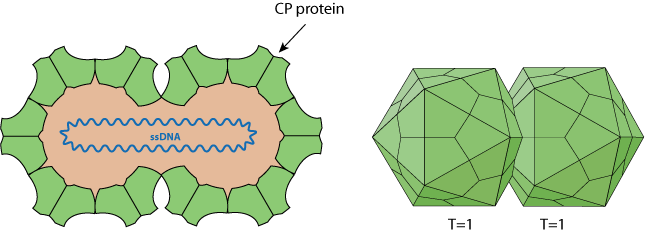VIRION

Non-enveloped, about 38 nm in length and 22 nm in diameter (for MSV), twinned (geminate) incomplete T=1 icosahedral symmetry capsid that contains 22 pentameric capsomers made of 110 capsid proteins (CP). Each geminate particle contains only a single circular ssDNA.
GENOME
Bipartite: components A and B (with some exceptions like TYLCV, ToLCV and AYVV which are monopartite), circular, ssDNA genome (+) of about 2.6 kb per component (5.2 kb in total). 3' terminus has no poly(A) tract. There are coding regions in both the virion (positive) and complementary (negative) sense strands.
The genome is replicated through double-stranded intermediates. The replication (Rep) protein initiates and terminates rolling circle replication, the host DNA polymerase being used for DNA replication itself. There is a potential stem-loop structure in the intergenic region that includes a conserved nonanucleotide sequence (TAATATTAC) where ssDNA synthesis is initiated. Component B is dependent on A for replication. The A and B components each have a common region (CR), which consists of a block of approximately 200bp within the IR and corresponds to the non-coding region common for topocu- and begomoviruses. The common region also contains two divergent promoters which differentially regulate the temporal expression of the viral genes.
GENE EXPRESSION
Transcription is bidirectional from the common region (CR). Proteins are expressed from subgenomic RNAs (sgRNAs). Leaky scanning is probably used for the expression of some of the overlapping proteins.
In bipartite begomoviruses, the A component encodes five or six proteins. On the v-sense: the CP. On the c-sense: Rep, a transcriptional activator (TrAP/AL2), a replication enhancer (REn), AC4, and, in some strains an optional protein AV2. The B component encodes two proteins involved in movement. BC1 on the c-sense and BV1 on the v-sense.
Monopartite begomoviruses encode six proteins: Rep, TrAP, CP, REn, C4, and V2.
ENZYMES
REPLICATION
NUCLEAR
- Virus penetrates into the host cell.
- Uncoating, the viral ssDNA genome penetrates into the nucleus.
- The ssDNA is converted into dsDNA with the participation of cellular factors.
- bidirectional dsDNA transcription from the IR promoter produces viral mRNAs and translation of viral proteins.
- Replication is initiated by cleavage of the(+)strand by REP, and occurs by rolling circle producing ssDNA genomes.
- These newly synthesized ssDNA can either
a) be converted to dsDNA and serve as a template for transcription/replication
b) be encapsidated by CP and form virions released from the cell by budding
c) be transported outside the nucleus, to a neighboring cell through plasmodesmata (cell-cell movement) with the help of viral movement proteins.


